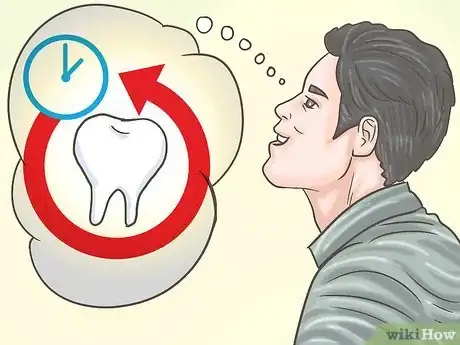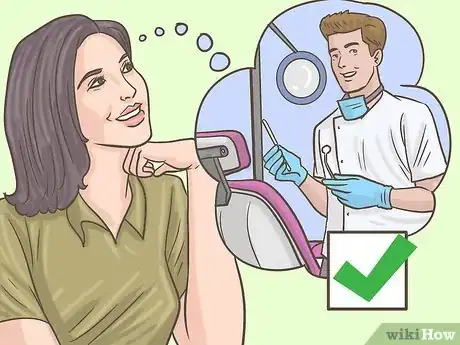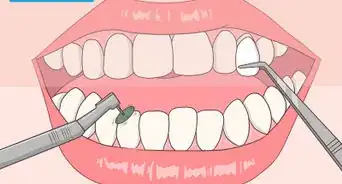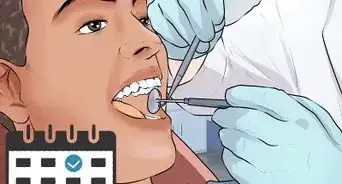This article was co-authored by wikiHow Staff. Our trained team of editors and researchers validate articles for accuracy and comprehensiveness. wikiHow's Content Management Team carefully monitors the work from our editorial staff to ensure that each article is backed by trusted research and meets our high quality standards.
This article has been viewed 58,070 times.
Learn more...
Choosing dental insurance can be a real drag. Between deductibles, co-pays, and premiums, who has time to figure out which insurance is best? It's more than a little confusing. But you've reached a point in your life where you've got to figure it out. Luckily, we've got you covered, so you can get just what you need to keep those pearly whites sparkling on a budget. Adulting for the win!
Steps
Deciding What Coverage You Need
-
1Figure out the best deductible for you. "Deductible" is probably a word you've heard thrown around a lot when it comes to insurance. A deductible is just an amount you must pay yourself before your insurance kicks in. If your deductible is $500, that means you must pay the dentist $500 in dental work before your insurance starts to pay anything. Deductibles reset each year, and some plans won't have a deductible.[1]
- If your teeth are relatively healthy, you may not even meet a $500 deductible in a year if you only get a single cleaning and x-rays done.
- Some plans have exceptions for maintenance work, meaning they will pay for basic dental work (like cleanings), but you must meet the deductible if you have anything extensive done.
- For deductibles, you have to guess how much work you'll get done. If you need a lot of work done, a plan with a low deductible is better, as you won't be paying as much out-of-pocket. Keep in mind that lower deductibles mean you'll pay more per month for insurance.
-
2Choose between PPO and DHMO. That may just sound like a bunch of letters. DHMO stands for dental health maintenance organization, while PPO stands for preferred provider organization. You're probably still confused, so take a moment to look more closely at how their names relate to their coverage.[2]
- A DHMO focuses on keeping costs low. Plus, things like cleanings and x-rays are covered without having to meet a deductible (though you may need to pay a co-pay). On the other hand, you won't have as many choices when it comes to dentists.
- A PPO gives you more freedom for deciding where to go, but you usually have to meet the deductible before any services are covered, even maintenance. Also, PPOs tend to be more expensive overall. Choose this plan if you want to be able to have a larger pool of dentists to choose from.
- You might run across one other type of plan, called an indemnity plan. These plans let you choose whomever you want for your dentist, and the insurance just pays a percentage.[3]
Advertisement -
3Weigh the yearly cap when picking a plan. The yearly cap, also called the limit or annual maximum, is how much an insurance company will pay for your coverage in a single year. Most dental coverage caps at $1,000 or $1,500, though you may be able to swing a higher cap with a higher premium.[4]
- Usually the cap doesn't include the maintenance work. So, if you've had two cleanings, plus $2,400 worth of dental work, only the $2,400 will count towards your cap.
- Obviously, if you need more work done, you'll want a higher cap. However, you're not likely to get much higher than $1,500 without paying more in premiums. Therefore, you must consider whether it's better to pay higher premiums or to eat the cost of the extra work.
- The $1,500 cap is only what insurance is paying. So if your plan covers 50% of the work, that means you can get $3,000 worth of work that year, with both you and the insurance company each paying $1,500.
-
4Pick a plan that has the coverage you need. When it comes to dental insurance, what's covered can vary a great deal. Most plans won't cover more than 50 to 60 percent of extensive dental work. Some plans will cover more maintenance, while others will cover more of the extensive work. When you're looking at plans, check to see what percentage of dental work it covers.
- You may find that one plan covers all maintenance work and 50 percent of all other work up to a capped number, such as $1,000. Other plans may not cover maintenance work, but they may offer coverage of up to 60 percent of all other work up to $1,500.
- If you're younger (under 40), you'll likely do better with a plan that covers maintenance, while if you're older, you may do better with a plan that covers more of the extensive work.
Narrowing Down Your Choices
-
1Check out the premium. Of course, cost is going to be a factor, and the premium is the only thing you'll pay consistently, which means you can stick it in your budget. A premium is the amount you pay each month to have insurance. Dental plans tend to be much cheaper than health insurance, usually under $50 a month. In theory, the higher the premium, the more coverage you get. However, that's not always the case, as premiums can vary widely by company.
- When comparing, make sure to compare benefits while also considering the cost of the premium. You're trying to get the highest coverage for the lowest premium. Think of it like a blanket. If two blankets cost $25 and $26 each and one covers your feet while the other doesn't, you're going to pick the one that also covers your feet, all else being equal. Dental insurance is the same way.
-
2Look at the waiting periods. If you need dental work yesterday, smaller waiting periods are going to be your friend. On many plans, you must wait a certain amount of time before you can get extensive work done. Other plans may even make you wait for maintenance work. That's because they know that people think about getting coverage for a month and then dropping it when they don't need it anymore.[5]
-
3Check reviews of the company. This step is where things can get a bit tricky. If you're just staring at numbers, you can just pick the lowest premium for the best coverage. However, service can vary from company to company, just like any industry. So once you've narrowed it down to a couple of plans, you may want to look at how customers have rated those companies.
Finding Insurance
-
1Choose a dentist. If you have a favorite dentist already in mind, you'll need to think about that when buying insurance. Not every insurance plan is going to cover every dentist. In other words, if you have a dentist you love, you need to make sure they're covered when you buy your plan, so you can keep going to the dentist who knows if you cringe at every dental procedure.[6]
-
2Look at group coverage. If you have a good job, you may be able to get dental insurance that way. Bonus, it will be cheaper because you're in a group. An insurance group just means you buy insurance with other people to make it cheaper.[7]
- You may be in other groups or organizations that you can use to purchase insurance. For instance, your college may give you a group rate, as well as groups like AARP. Medicaid and the Affordable Care Act Marketplace may also offer discounted rates.
-
3Comparison shop. You know to comparison shop when you're buying other items. You comparison shop on everything from spaghetti sauce to a new car. A health insurance plan is no different. You can do the legwork yourself, but you'll save some legwork if you use an online plan comparison tool.
- These tools let you select several plans in your price range. Then you can compare what kind of coverage and deductible each plan has.
References
- ↑ http://www.investopedia.com/terms/d/deductible.asp
- ↑ https://mydental.guardianlife.com/blog/2016/01/whats-the-difference-between-ppo-and-dhmo-dental-insurance-plans/
- ↑ http://www.bankrate.com/finance/insurance/dental-insurance-1.aspx
- ↑ http://www.bankrate.com/finance/insurance/dental-insurance-1.aspx
- ↑ http://www.investopedia.com/articles/personal-finance/120914/4-important-steps-choosing-dental-insurance.asp?lgl=myfinance-layout
- ↑ http://www.investopedia.com/articles/personal-finance/120914/4-important-steps-choosing-dental-insurance.asp?lgl=myfinance-layout
- ↑ http://www.investopedia.com/articles/personal-finance/120914/4-important-steps-choosing-dental-insurance.asp?lgl=myfinance-layout







































































